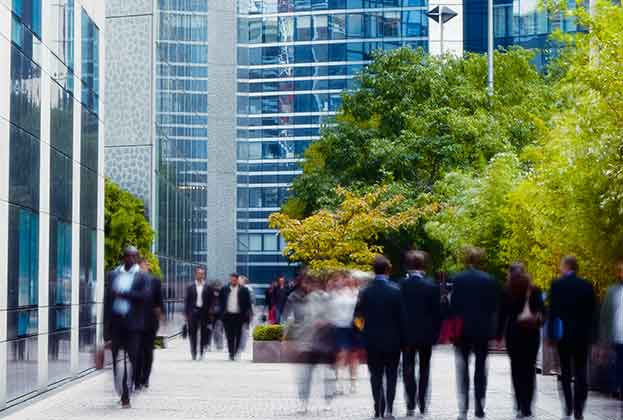Real Estate Investment Market in France Record Breaking 2018
The year of 2018 will remain as the year that saw, for the first time, the French market surpass the benchmark of €31 billion invested in real estate. The previous record was set in 2016, when it rose to just above €30 billion.
These figures include the total transactions expected to be signed before the end of the year. However, the last days of December are likely to see some additional divestments, which would bring the market up to €32 billion.
Compared to 2017, there has been an increase of 14%.
Ile-de-France continues to take the lion’s share. With €20.1 billion, the Paris region made up 65% of the amount invested on a national level. It increased, however, more slowly than the rest of the French territory showing an annual increase of only 4%.
The regional markets have, for them, seen a very strong 2nd quarter in 2018, which allowed them to reach an investment volume of €9.2 billion for the whole year, which represents a 16% increase compared to 2017.
The balance of activity (€1.7 billion) is concentrated in national portfolios.
Such a performance in the investment market reflects a double attractiveness:
- That of real estate assets, which appear to be investments that retain an attractive return for a controlled level of risk
- That of the French market, in a very uncertain international environment, draws in more and more foreign investors.
As such, the acquisition of 79 avenue des Champs-Elysees by Norges Bank sovereign fund, for more than €610 million, symbolizes this confidence.
.jpg)
French investors certainly remain dominant, taking up 58% of the volume invested on a national scale. Their part of the market is, however, on the decrease compared to 2017: they were then responsible for 75% of the sums spent on the acquisition of commercial real estate. This decrease is explained, in part, by the decrease observed at the beginning of the year in collections of SCPIs and OPCIs, in the wake of the establishment of the IFI. Even if this phenomenon was partially compensated for in the 2nd quarter, it limited the activity of certain buyers, who had played a key role throughout past years.
Yet this explanation is not the only one responsible for the decrease in the representation of French investors: they have equally been subjected to the strong competition by international buyers, for whom France is becoming, or becoming again, a priority.
It is notably the case for German investors, which the proportion of amount invested by them went from 4% in 2017 to 13% in 2018. They have, in this way, become again the principal foreign buyers on the French market.
They are followed by the Americans, for whom the proportion of the market has increased from 3% to 9% in one year. The British are equally showing signs of a good performance, with 8% invested in 2018 (against 4% in 2017)
Only the Asian investors are on the decrease in 2018. It must be said that it was difficult to imagine a reoccurrence of their 2017 performance, propelled by the acquisition by China Investment Corp of the logistics portfolio Logicor for €1.7 billion. The restrictions on capital overflows from China have also contributed to the lower representation of Asian investors.
In terms of the make-up of bought assets, the office buildings remain dominant. With more than €21.5 billion, they represent 69% of volume invested in France. Their proportion is, however, on the decrease following the 71% volume invested in 2017. The office sector, essentially Parisian, is seeing limited activity due to the unwillingness of certain owners to put on sale potentially arbitrary assets, and due to the emergence of alternative assets. These reasons are notably contributed to by what is called service real estate (seniors’ accommodation, student accommodation, clinics or hotels).
The strong rise in this sector is one of the noteworthy occurrences of 2018. It has increased by 150% in terms of volume on a French scale. Driven by the growing interest by investors for seniors’ and student accommodation, it has seen its sector go from 4% to 7% in the amount invested in France.
Traditionally driven by activities in the provinces, retail, for its part, has suffered from the caution taken in acquisition opportunities of shopping centres, notably in small and medium sized towns. If the investments of assets in commerce have grown in volume, it is essentially due to the continued appetite for retail premises at the foot of buildings situated at prime addresses. Activity thus was concentrated on a few large Parisian properties, like 79 and 114 Avenue des Champs-Elysées.
The Industrial sector, essentially carried by the logistics platforms, are showing, for its part, an increase of 6%: this performance is noteworthy given the results of 2017, propelled by the exceptional transaction of Logicor portofolio. While this did not happen again, 2018 was driven by the sale of several significant portfolios: 7 transactions of more than 150 million euros were recorded, all carried out by international investors such as the British Gramercy and M7 Real Estate, the Americans GreenOak and Blackstone or the German Deutsche Bank.
Offices, retail, industry, or services: the success seen in 2018 by the French market explains the stabilizing of yield rates, at least for the Prime assets. This stabilization happened at very low levels: the market remains at a historic low, at 3% for the Core QCA office and at 2.5% for retail premises at the foot of buildings located at the most attractive addresses in Paris. These levels continue nevertheless to provide a high yield advantage for the real estate segment since the spread with the bond rate stood at 229 basis points in mid-December 2018, significantly above its ten-year average (199pdb).
These elements lead us to think that the upsurge of yield rates is not expected in the coming months, even if the more restrictive policies of the European Central Bank, announced for summer 2019, will produce its long-term effects.
With these excellent results, 2018 confirms the change in dimension of the French market, which establishes itself as a destination of choice on the European level. Nothing better to open the vintage year of 2019 in the best conditions…
.jpg)








